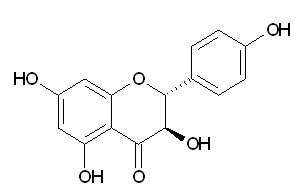| Catalogue number | C103945 |
| Chemical name | Aromadendrin |
| CAS Number | 480-20-6 |
| Synonyms | (2R,3R)-3,5,7-trihydroxy-2-(4-hydroxyphenyl)-3,4-dihydro-2H-1-benzopyran-4-one |
| Molecular Weight | C15H12O6 |
| Formula | 288.3 |
| Purity | 98% |
| Physical Description | Powder |
| Solvent | Chloroform, Dichloromethane,DMSO |
| Storage | Stored at 2-8°C, Protected from air and light, refrigerate or freeze |
| Applications | Agents that stimulate glucose uptake and improve insulin resistance may be useful in the management of type 2 diabetes mellitus (DM). Thus, the aims of this study were to assess the effects of aromadendrin on stimulation of glucose uptake and improvement of insulin resistance and to characterize the molecular mechanisms underlying these activities. Insulin-stimulated glucose uptake was measured in HepG2 cells and in differentiated 3T3-L1 adipocytes using 2-[N-(7-nitrobenz-2-oxa-1,3-diazol-4-yl)amino]-2-deoxy-D- glucose (2-NBDG), a fluorescent D-glucose analog. Expression of the peroxisome proliferator-activated receptor-γ2 (PPARγ2) and adipocyte-specific fatty acid binding protein (aP2) mRNAs and the PPARγ2 protein was analyzed in adipocytes using RT-PCR and immunoblotting, respectively. Insulin-stimulated protein kinase B (Akt/PKB) phosphorylation was measured in high glucose-induced, insulin-resistant HepG2 cells. Similar to 30 µmol/l rosiglitazone, treatment with 30 µmol/l aromadendrin significantly stimulated insulin-sensitive glucose uptake in both HepG2 cells and 3T3-L1 adipocytes. Aromadendrin treatment also enhanced adipogenesis and caused increases in the expression of PPARγ2 and aP2 mRNAs and the PPARγ2 protein in differentiated 3T3-L1 adipocytes. In high glucose-induced, insulin-resistant HepG2 cells, aromadendrin reversed the inhibition of Akt/PKB phosphorylation in response to insulin, which could be abrogated by pretreatment with LY294002, a phosphatidylinositol 3-kinase (PI3K) inhibitor. Aromadendrin treatment induced adipogenesis by increases in PPARγ2 expression, resulting in stimulation of glucose uptake and ameliorated insulin resistance. These findings suggest that aromadendrin may represent a potential therapeutic candidate for the management of type 2 DM. |
| References | 1. J. Integr. Plant Biol., 2006, 48, 996-1000. 2. Australian Journal of Scientific Research, 1952, 5(2), 379-386. 3. Chemical and Pharmaceutical Bulletin, 1988, 36(5), 1877-1881. 4. Pharmacology, 2011, 88, 266-274. |
| Guestbook |
After Receiving
The packaging of the product may have turned upside down during transportation, resulting in the product adhering to the neck or cap of the vial. take the vial out of its packaging and gently shake to let the compounds fall to the bottom of the vial. for liquid products, centrifuge at 200-500 RPM to gather the liquid at the bottom of the vial. try to avoid loss or contamination during handling.
Featured Products
| C104280 | 3-O-Feruloylquinic acid | $422.00/5mg |
| C108063 | 11-Keto-beta-boswellic acid | $134.00/5mg |
| C101069 | 6’,7’-Dihydroxybergamottin | $514.00/5mg |
| C108534 | Isochlorogenic acid A | $110.00/20mg |
| C108536 | Isochlorogenic acid C | $166.00/20mg |

Price(USD)
| Size | Price(USD) | Discount |
| 5mg | Inquiry | N/A |
| 10mg | Inquiry | N/A |
| 25mg | Inquiry | N/A |
Orders by E-mail
Orders can be placed by Emails. All orders received will be shipped in the next day if the stock is available.
To place an order, please provide the following information.
1) Your name and telephone number
2) Purchase order number
3) Product number, package size, description, and quantity
4) Shipping and billing addresses
Sent to your order to our email: info@coompo.com
To place an order, please provide the following information.
1) Your name and telephone number
2) Purchase order number
3) Product number, package size, description, and quantity
4) Shipping and billing addresses
Sent to your order to our email: info@coompo.com
Discount Request
If you have any questions about discounts or dealer discount, please send us a message. We will be glad to help.

